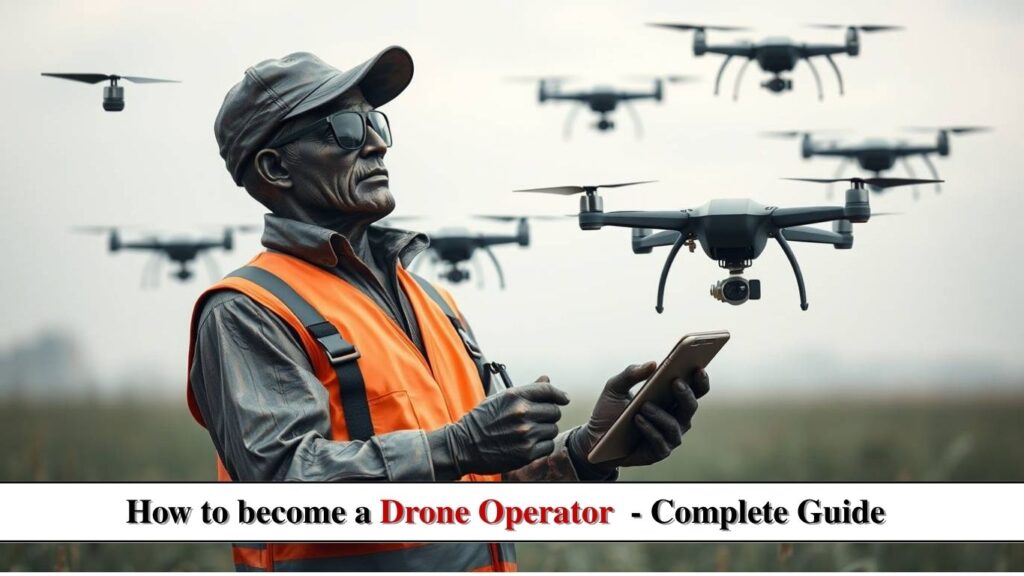
Introduction
Drones, or Unmanned Aerial Vehicles (UAVs), have transformed industries like filmmaking, agriculture, defense, and logistics. Behind every successful drone flight is a skilled Drone Operator—a professional trained to pilot, maintain, and optimize UAVs for various applications.
If you’re fascinated by aviation, robotics, and cutting-edge technology, a career as a Drone Operator could be your perfect fit. This comprehensive guide covers:
- History of Drones & Drone Operations
- Roles & Responsibilities of a Drone Operator
- Salary Expectations Worldwide
- Required Qualifications & Certifications
- How to Get Started (Step-by-Step Guide)
- Future Scope & Industry Trends
Let’s take off! 🚁
History of Drones & Drone Operations
Drones weren’t always the compact, AI-powered machines we see today. Their origins trace back to military applications in the early 20th century.
Key Milestones in Drone Evolution:
- 1916: The Hewitt-Sperry Automatic Airplane was the first unmanned aerial vehicle (UAV).
- 1930s: The UK developed the Queen Bee, a radio-controlled target drone.
- 1980s: Israel pioneered modern military drones like the IAI Scout.
- 2006: The FAA issued the first commercial drone permit.
- 2010s: DJI popularized consumer drones for photography & videography.
- 2020s: Companies like Amazon Prime Air & Zipline use drones for deliveries & medical supply drops.
Today, drones are used in filmmaking, agriculture (crop monitoring), surveillance, disaster management, and even drone racing!
Roles & Responsibilities of a Drone Operator
A Drone Operator does much more than just fly UAVs—they ensure safe, efficient, and mission-compliant operations.
Key Responsibilities:
- Pre-Flight Planning
- Check weather conditions, airspace restrictions, and flight paths.
- Obtain necessary permits & waivers (e.g., FAA Part 107 in the USA).
- Drone Piloting & Navigation
- Operate manual & autonomous flights.
- Monitor battery life, GPS signals, and obstacle avoidance systems.
- Data Collection & Analysis
- Capture aerial photos, videos, LiDAR scans, or thermal imaging.
- Process data using GIS (Geographic Information Systems) & photogrammetry software.
- Maintenance & Troubleshooting
- Perform routine checks on motors, propellers, and sensors.
- Diagnose and fix technical malfunctions.
- Regulatory Compliance
- Follow local aviation laws (e.g., FAA, EASA, DGCA).
- Maintain flight logs and incident reports.
Industries Hiring Drone Operators:
- Aerial Photography & Videography (Movies, Real Estate)
- Agriculture (Crop Monitoring, Precision Farming)
- Construction & Surveying (3D Mapping, Land Surveys)
- Search & Rescue (Disaster Response)
- Delivery & Logistics (Amazon, Zipline)
Drone Operator Salary (2024)
Salaries vary based on experience, industry, and location.
Average Annual Salaries:
| Country | Entry-Level | Mid-Level | Senior-Level |
|---|---|---|---|
| USA | $45,000 | $70,000 | $100,000+ |
| UK | £25,000 | £40,000 | £60,000+ |
| Canada | CAD 50,000 | CAD 75,000 | CAD 90,000+ |
| India | ₹3 LPA | ₹6 LPA | ₹10 LPA+ |
Top Employers:
- DJI, Amazon Prime Air, AeroVironment, Zipline, Surveying Firms
Qualifications & Skills Required
Educational Background:
- High School Diploma (Minimum)
- Preferred Degrees:
- Aeronautical Engineering
- Robotics & Automation
- GIS (Geographic Information Systems)
- Film/Photography (for cinematography drones)
Certifications (Mandatory in Many Countries):
✔ FAA Part 107 (USA) – Commercial Drone License
✔ A2 CofC (UK/EU) – Competency Certificate
✔ DGCA Drone License (India)
✔ PfCO (Permission for Commercial Operations – UK)
Technical Skills:
- Drone Pilot Proficiency (Manual & Autonomous)
- Photogrammetry & GIS Software (Pix4D, DroneDeploy)
- Basic Electronics & Repairs
- Video Editing (Adobe Premiere, DaVinci Resolve)
Soft Skills:
✔ Attention to Detail
✔ Problem-Solving
✔ Communication (for client-based work)
How to Become a Drone Operator (Step-by-Step Guide)
Step 1: Learn the Basics
- Understand drone types (Multi-rotor, Fixed-wing, Hybrid).
- Study aviation regulations in your country.
Step 2: Get Certified
- Enroll in an FAA Part 107 course (or equivalent).
- Pass the written exam & flight test.
Step 3: Gain Hands-On Experience
- Start with an affordable drone (DJI Mini Series).
- Practice manual flying, waypoint navigation, and emergency recovery.
Step 4: Build a Portfolio
- Offer free/paid gigs for real estate, event photography, or farming surveys.
- Showcase work on YouTube, Instagram, or a personal website.
Step 5: Apply for Jobs or Freelance
- Look for openings in cinematography, surveying, or logistics.
- Join drone operator networks (DroneBase, Upwork).
Future Scope of Drone Operators
The global drone market is projected to reach $54.6 billion by 2030 (Grand View Research).
Emerging Trends:
🚁 AI-Powered Drones – Autonomous inspections & deliveries
🌾 Agricultural Drones – Precision pesticide spraying & yield analysis
🚚 Last-Mile Delivery Drones – Amazon, UPS, and Walmart testing drone deliveries
🚒 Emergency Response Drones – Firefighting & disaster assessment
Job Growth:
- 13% annual growth in drone-related jobs (BLS).
- High demand in USA, UAE, Australia, and India.
Conclusion
A career as a Drone Operator offers exciting opportunities in multiple industries, from filmmaking to disaster management. With the right training, certifications, and experience, you can turn your passion for drones into a lucrative profession.
Key Takeaways:
✅ Get certified (FAA Part 107 or equivalent).
✅ Practice flying and master data processing tools.
✅ Stay updated with AI & automation trends in drone tech.
The sky’s the limit—are you ready to take flight? ✈️
By following this guide, you’ll be well on your way to launching a successful career as a Drone Operator in this fast-growing industry! 🚀













Post Comment